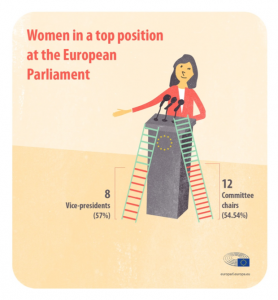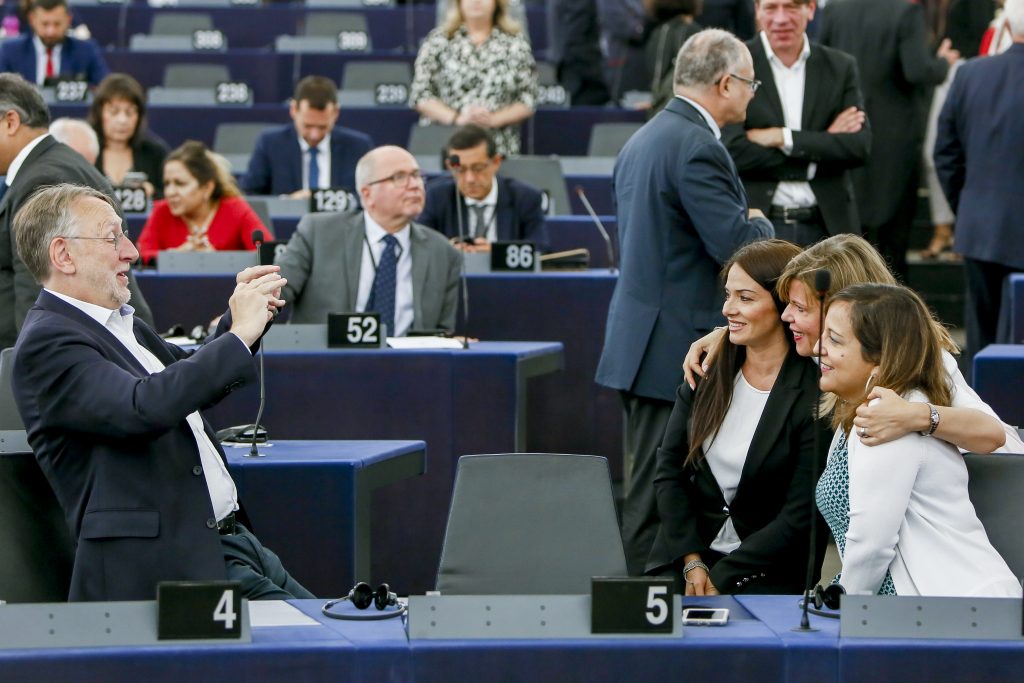 Oriana Henry is an alumna of the Institute for European Studies of the ULB where she completed a Master’s programme in European Studies in the political science track. Her final dissertation focused on Women’s descriptive and substantive representation in the European Parliament She now works at the Institute for European studies as a communication and project management assistant.
Oriana Henry is an alumna of the Institute for European Studies of the ULB where she completed a Master’s programme in European Studies in the political science track. Her final dissertation focused on Women’s descriptive and substantive representation in the European Parliament She now works at the Institute for European studies as a communication and project management assistant.
In May 2019, more women than ever entered the European Parliament, representing 40.4 percent of the elected MEPs, up 4 points from the 2014-2019 legislative term. The increase in women representation in democratic bodies throughout Europe is an essential component of ensuring an even implementation of gender-mainstreaming in all EU policies.
But why does gender representation matter? Do women represent women? Can the number of women seating in a Parliament make an impact on gender equality in policies? These were the questions I looked into while doing research for my Master’s thesis entitled: “Women’s descriptive and substantive representation in the European Parliament. A journey into gender-mainstreaming and the MFF”.
The European Parliament is an interesting case to look at women representation in European politics, as it has a long history of willingness to promote gender equality.
From numbers to actions: what the scientific literature tells us
Scholars have acknowledged that a lack of women representation in politics can jeopardise the advancement of gender equality on the agenda and can result in “transforming unequal and unjust power relations” in the decision-making.
Reaching gender equality and parity within the institutions has therefore become a subject of many debates in order to find solutions to overcome cultural, socioeconomic and structural barriers.
The current debate in the literature and in politics has shifted towards whether we should or not focus on the number of women elected and/or appointed, to whether the issue of gender equality lays beyond the numbers and who does what in Parliament.
Feminist and political science research looking into these questions are divided between two opposite perspectives of women’s representation. Political scientist and specialist in Gender Studies, Joni Lovenduski coins them as equality and difference feminism. The first one focuses on “women’s entitlements to be in politics on the same terms and in the same numbers as men”, while the latter relies more on the idea that women have a specific set of characteristics, experiences, and interests that make them the only ones able to represent women.
These two currents of thoughts also match two tools that have been put into place to measure the impact of increasing the number of women in assemblies: critical mass (equality feminism) and politics of presence (difference feminism).
Two theories, two matters for debate
Critical mass focuses on the theory that the key matter is having a sufficient (critical, i.e. at least 30 percent) number of women in order for a transformation in the policy outcome to actually happen.
“[it] links women’s descriptive representation to policy change through the linchpin of a threshold number which, once surpassed, has a transformative impact upon legislatures and serves to produce policy change.” — Beckwith, 2007
 The European Union has actually committed since the mid-1990s to implement this critical mass threshold of women representation in its institutions through the ratification of the Beijing Platform for Action. It has been a long way coming for the European Parliament, which has only overpassed 30 percent of female MEPs in 2009. Moreover, we should not rejoice too quickly, as equal gender representation in top position in the European Parliament (Vice-Presidents and committee chairs) has only been reached in the 9th legislative term.
The European Union has actually committed since the mid-1990s to implement this critical mass threshold of women representation in its institutions through the ratification of the Beijing Platform for Action. It has been a long way coming for the European Parliament, which has only overpassed 30 percent of female MEPs in 2009. Moreover, we should not rejoice too quickly, as equal gender representation in top position in the European Parliament (Vice-Presidents and committee chairs) has only been reached in the 9th legislative term.
The 30 percent mark has been widely used by activists and lobbyists to advance the idea of more parity into parliaments. This critical mass is legitimised as a response to the equality principle, for equal rights amongst citizens. It is still used and widespread across the world and has been recognised as having produced changes in countries like South Africa. However, there is still no evidence of a more major impact of critical mass onto public policies.
More scholars argue that this theory is actually quite weak to explain a transposition of descriptive representation into substantive representation and that no automatic change can be expected.
Lovenduski has also argued that relying on critical mass, and the mere presence of women into institutions to be a determinant of change, means putting pressure onto women to deliver, and as fast as possible, these changes. This includes a risk of them to be accused of not fulfilling their mission and what was expected of them. Should women carry on their own the burden of ensuring more gender equality in the legislation?
On the opposite point of view, it is argued that critical mass is key to women’s representation as it is a necessary step into creating a transformation that is compulsory in order for substantive representation to be achieved. In the end, it is as important to look at numbers as it is to consider the other factors.
On the second hand, politics of presence literature says that the most important reason for promoting women’s inclusion as members of parliament is that women are required to be present in order to “speak for other women in those policy areas where they have a different experience and different interests from men as a group”.
Politics of presence looks beyond the numbers and can be considered as in opposition to critical mass by arguing that there are more than numbers to women’s substantial representation in politics. This perspective resonates in the political world as it is how the United Nations (UN) recognises the importance of women in politics and describes their absence as such:
nations that exclude women from decision making or are content with the low levels of participation by women are not only unwisely and unnecessarily depriving themselves of a rich reservoir of talent, experience and wisdom, they are also missing out on the qualitatively different approach that women bring to the decision-making process.—United Nations
The presence theory is very much developed and used in the literature, but we see little testing of its applicability and empirical results. The main point to be argued against this theory relies on its essentialism. Women cannot be considered as a homogenous group: women are not just women.
Why does women representation matter in the European Parliament?
A little over twenty years after this first commitment, it is now argued that the European Union has made little progress in terms of gender-mainstreaming because it did not get the incentives for it right. Because of the difficulty of this process, most of the literature has engaged with gender-mainstreaming as a dependant variable: how have institutions implemented a gender-sensitive approach into their policy outcomes? Gender-mainstreaming is about addressing gender equality in the long-term. This distance with the delivery of its objectives can make it hard for policymakers to foresee such results.
While the politics of presence gives the basis for theorising gender differences and political representation, critical mass is a descriptive sign of the minimum number of women needed in order to create a substantial difference in the decision-making.
Democratic theorists argue for the representation of women in parliaments in the same proportion as their presence in the population. This is a reaction to decades of representation during which large groups of minorities or part of the population have been excluded from the decision-making.
One of the most powerful arguments in favour of pushing for more representation and a feminisation of politics is probably a justice based one.
The underrepresentation of women is unfair at all levels in a democracy. It is unfair from men to monopolise power especially in modern democracies. There is no argument from justice that can defend the current state of affairs; and there is an argument from justice for parity between women and men.
The path to challenge women’s underrepresentation in the European Parliament is a work in progress but much remains to be done.
| COMMITTEE | MEMBERS (inc. deputy members) | WOMEN | % OF WOMEN |
| AFET | 140 | 35 | 25% |
| DEVE | 51 | 27 | 53% |
| INTA | 83 | 27 | 32% |
| BUDG | 78 | 17 | 22% |
| CONT | 53 | 16 | 30% |
| ECON | 110 | 34 | 30% |
| EMPL | 105 | 70 | 66% |
| ENVI | 156 | 76 | 49% |
| ITRE | 150 | 56 | 37% |
| IMCO | 90 | 41 | 45% |
| TRAN | 97 | 38 | 39% |
| REGI | 82 | 35 | 43% |
| AGRI | 93 | 36 | 39% |
| PECH | 54 | 22 | 41% |
| CULT | 58 | 25 | 43% |
| JURI | 48 | 15 | 31% |
| LIBE | 133 | 58 | 44% |
| AFCO | 55 | 11 | 20% |
| FEMM | 62 | 55 | 89% |
| PETI | 60 | 22 | 37% |
As of March 2020, the composition of parliamentary committees is as represented in the table above: three committees still do not reach the critical mass level set at the Beijing Platform for action of 30 percent (AFET, BUDG, AFCO); four committees are just barely at the level or a little above it (INTA, CONT, ECON, JURI). There is a nearly ‘perfect’ parity in three committees (DEVE, ENVI, IMCO), and women are overrepresented in two committees (EMPL and FEMM).
This repartition is also a reflection of labour division between men and women: women are overrepresented in areas of ‘soft’ policy areas (i.e. health, culture, education and social welfare), and men in more ‘prestigious’ policy areas (i.e. economy, finance, defence, human affairs and foreign affairs).
In a resolution adopted on January 15th 2019, the European Parliament acknowledges this lack of representativeness by stating: “whereas the population of the European Union consists half of women and half of men, but the composition of the European Parliament reflects a severe female underrepresentation as only 36,1 percent of MEPs are female”.
As the EU’s competences have expanded, it is interesting to look specifically at the European Parliament as a place of decision-making. There is a democratic component to gender-mainstreaming EU policies: it is not only about including the gender dimension into policies, but also about representativeness. Ensuring direct representativeness of EU citizens is the job of the European Parliament.
As the only directly elected body, the Parliament acts as the voice of those who have elected them. Placing advocates of gender equality in the European Parliament is a means to challenge the bureaucratic and technocratic discourse around which the EU institutions have been built, and as an institutionalisation of male dominance in politics.
Making a difference: to be a feminist or not to be?
In the existing literature on politics of presence we see that female elected representative tend to look out more for women. There are examples throughout national politics: in the U.K. in the 1990s, it was women MPs who have led the way and fought for parental leave or equal pay.
We can also argue for the opposite that men are poor allies and advocates of women related issues. One current example of such argument is Donald Trump’s current administration introducing new rules to compromise women’s resources and freedoms such as the Global Gag Rule removing state’s funds from organisation linked to abortion.
In another recent example, austerity measures in Europe implemented by male Heads of States and governments have disproportionately impacted women.
However, not all women are feminists and want to engage with women related issues. But also, not all feminists are women. But the question is not only ‘what kind of difference can women MEPs make?’, but also ‘what differences are we expecting from them?’.
If the question of what difference will women make is not always justified, it is inevitable to understand gender relations and gendered institutions.
For decades, States and governance have been “culturally marked as masculine and functions largely as an institutionalisation of the power of men” — Suzanne Franzway, Dianne Court, and Raewyn Connell, 1989
Men have long dominated, and still do, in many levels of decision-making and power, and the European Union is no less than a reproduction of this system.
However, we can also argue that the EU has not always solely embodied males’ interest, as it has made major breakthrough into advancing women’s related issues on the agenda. This opposition between the two makes it possible to promote women’s interests when in a specific time and context.
Women have the power to foster change in the institutional hierarchy and in policy outcomes, just as institutions through socialisation push women to become politicians just like their male peers by tending to erase gender differences.
Oriana Henry’s Master’s thesis is available in full here.




